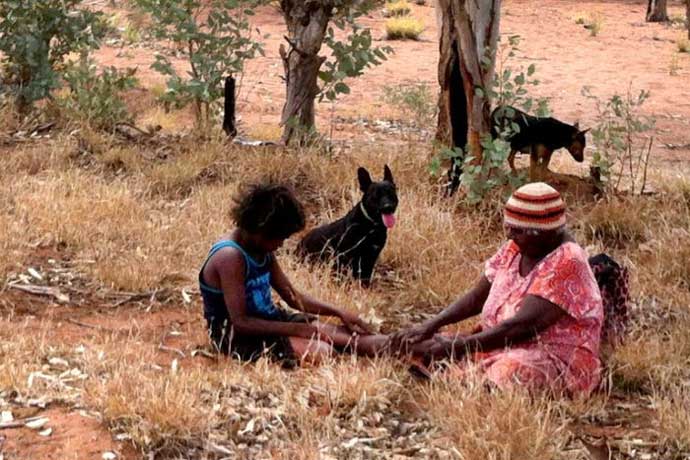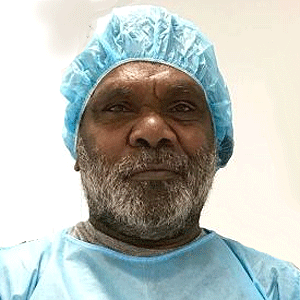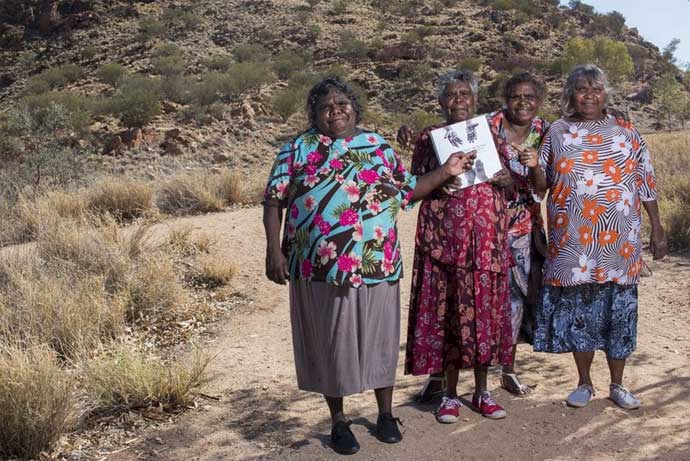First Nation healers working to keep traditional medicine alive
In the Anangu Pitjintjatjara Yangkunjatjara lands in northern South Australia, Ngangkari healers work alongside doctors and medical staff in community clinics and hospitals, and often visit Adelaide to attend to Indigenous hospital patients.
In the mental health area their involvement in the care of Aboriginal people is even enshrined in state law, and Ngangkari deal with everything from childhood illnesses to loss of spirit.

Iwana Antjiakitja from Kaltjti (Fregon community) in APY Lands (Image: Anangu Ngangkari Tjutaku)
Annie Hastwell ABC AWAYE 23 May 2014
Aboriginal health may be high on the policy agenda, but traditional Aboriginal healers hardly rate a mention in Australia's official health policies. Annie Hastwell meets an Italian researcher who is determined to raise their profile and bring them into the mainstream.
When Dr Francesca Panzironi came to Australia several years ago to study how international legal standards related to Aboriginal traditional medicine, she was amazed at the lack of research or recognition of this 40,000-year-old body of knowledge.
"I had been aware that globally Australia is recognised as having advanced policy development and support for traditional medicine," she says, "but it turned out this was because of the official embrace of Chinese medicine. I couldn't believe that there was a complete dismissal at an official level of Indigenous health practice."

Ngangkari healers: 60,000 years of traditional Aboriginal methods make headway in medical clinics
Ngangkari healers were considered the treasure of Aboriginal communities, and now their culture has made its way to South Australia's Royal Adelaide Hospital and rural clinics. Eighteen registered Ngangkari healers set up the Anangu Ngangkari Tiutaky Aboriginal Corporation (ANTAC) more than seven years ago.
READ MORE
So began a journey that has led the Italian legal academic deep into the desert heart of Australia, where a different picture emerged. In the Anangu Pitjintjatjara Yangkunjatjara lands in northern South Australia she found that traditional health knowledge was still alive and well, and working in a contemporary setting. There, Ngangkari healers work alongside doctors and medical staff in community clinics and hospitals, and often visit Adelaide to attend to Indigenous hospital patients. In the mental health area their involvement in the care of Aboriginal people is even enshrined in state law, and Ngangkari deal with everything from childhood illnesses to loss of spirit.
"They focus a lot on pain relief, pain management and spiritual disorders," explains Panzironi, "so when people feel sick or weak they may say the spirit is not there or it's not in the right place. Through massage and using special powerful sacred tools they are able to return the spirit to its rightful place."
The road to becoming a Ngangkari can begin as a toddler, when a child is identified by family and community members as being a natural healer. Cyril McKenzie is from Ernabella in the northern South Australian desert and says he's been doing the job since he was "a young fella".
"When I was five years old I started healing, and when I grew up then I started work at the clinics, and then in mental health," he says.
McKenzie says he learnt his skills from his grandfather, uncle and mother. He and fellow healer Rama Sampson found themselves very much in demand at a recent healing expo in Adelaide. It was the first time many urban Aboriginal people had a chance to consult them and there were plenty of requests from non-Indigenous people as well.
The two men worked intensely all day, applying their hands-on therapy to a never ending queue of patients. One woman, an Aboriginal health administrator, almost danced out of the tent, ecstatic that the knee pain that had immobilised her for years had disappeared. "I could feel them massaging the tender spots and then pulling something down my leg and I actually felt it leave my body," she says.
McKenzie says that among the patients he saw that day were a couple whose spirits had left their bodies and were following them around.
Ngangkari healers Rama Simpson (left) and Cyril McKenzie - 'New' diseases like diabetes and substance abuse they find more difficult to deal with, but when the 'two way' system is working, when Aboriginal people are given the choice of western or traditional medicine, the choice will often be a combination of both. The spin-off is an increase in Aboriginal patients' confidence in the health system.
'When that happens, when your spirit leaves your body, you better start looking around for a Ngangkari,' he chuckles. 'That"s our job; it"s not for doing an operation or giving medication.'
In South Australia, Ngangkari are often used in mental health and in the prison system to calm someone who is troubled or whose behaviour is out of control. Through a combination of coaxing and massage, they say they are able to restore the spirit balance within the body.
"I know from a western scientific point of view there is not a category to classify this kind of diagnosis," says Panzironi, "but this is what they see, this is what they do, and people's reaction is very positive."

Ngangkari healers of NPY lands bridge divide between Western healthcare and traditional care
Navigating the complexities of Western medicine can be a challenging and even frightening experience for Aboriginal people of Central Australia. Making that journey a little easier are the traditional healers of the NPY lands, the Ngangkari.
For thousands of years before white settlement, their system of healthcare encompassed physical, social and emotional wellbeing, passed down from community elders.
READ MORE
Zane Gunter, who has worked as a bush nurse around Maralinga for 30 years, says the world view of a Ngangkari is very different to the western model.
"To them, the spirit world is very real, rather than our western model which is based around germ theory," says Gunter.
Gunter, like many other medical staff Panzironi met and interviewed during her research, has frequently watched the local healers succeed where western medicine was failing.
In other cases the Ngangkari turn to doctors for help, or will advise that a patient needs to go to hospital when the problem is outside their area of expertise. They find "new" diseases like diabetes and substance abuse more difficult to deal with.
Gunter says that when the two-way system is working, when Aboriginal people are given the choice of western or traditional medicine, the choice will often be a combination of both. The result, he and Panzironi both agree, is an increase in Aboriginal patients' confidence in the health system.
However, despite of the respect accorded to Ngangkari, they remain on the margins of the health world. SA Health has a policy of cultural respect, which means all efforts are made to find a traditional healer if someone wants one, but Ngangkari are engaged and paid in an ad hoc fashion, with funding directed through NGOs and other agencies. They have no official status or pay scale, and what they earn for their work varies wildly.
There are many reasons for this: the logistics and cost of getting people from remote areas to the city, the difficulty of a government department engaging them in a system where employees need ABNs and bank accounts, and the lack of any system of formal accreditation. On top of that are cultural issues, with many people only comfortable seeing Ngangkari they relate to.
However, when Panzironi arrived in Australia she didn"t see these things as obstacles. What she did see was a country out of step with other countries with indigenous populations. "In New Zealand you can walk into a clinic and you can choose between seeing a western doctor or a traditional healer. It"s a two-way system. Canada has the same."
"There's research being done on differences and common characteristics of healing, and studies on the extent to which traditional healing can help in recovery process," she says. "Australia is quite far behind compared to other countries." She quotes Africa and South America as places where there are national associations of indigenous healing, recognised and funded by the government.
Last year, after years of dividing her time between Sydney and the desert, Panzironi published her report, Hand in Hand which argued for policy change so that traditional healing could be given an official role within the Australian health system. At the moment, she says, its absence from the Closing the Gap framework is mystifying. Her report presents anecdotal evidence that if healers were recognised and employed as part of a two-way system they could have a very positive effect on Aboriginal health.

NPY Women's Council Ngangkari team have a new book named 'Traditional Healers of Central Australia: Ngangkari'. This publication is a follow up to the popular Ngangkari Work – Anangu Way. Published by Magabala Books, it is available from good bookstores nationally, Magabala Books and via NPY Women's Council's website.
The release of Hand in Hand coincided with the launch of Australia's first association of traditional healers, the Anangu Ngangkari Tjutaku Aboriginal Corporation (ANTAC).
To them, the spirit world is very real, rather than our western model which is based around germ theory.
ANTAC registers Ngangkari, with accreditation managed by the board of five senior male and female Ngangkari. So far there are 14 Ngangkari in the association, and they smile proudly on the website, ready to be employed.
Employment is a key issue, says Panzironi. The body of healing knowledge is alive and well in remote communities, where young Ngangkari continue to be trained.
"There is a qualified Aboriginal health workforce waiting just to be employed and this is what ANTAC wants to do, to create an employment pathway for a qualified traditional workforce."
So far all the healers in the association are from the APY lands, but her next move is to begin exploring what is happening elsewhere in Australia.
"The Ngangkari tell me there are a lot of traditional healers in WA and the NT and they exchange views and they are very enthusiastic about having a national association."
With increasing demand for traditional healing services from non-Indigenous people and interest from doctors in collaborating in research into pain management and other topics, Panzironi is upbeat about the future.
She hopes one day to see two-way healing offered to Aboriginal people in the city and the country, and clinics where Ngangkari have a dedicated space rather than the "spare room".

